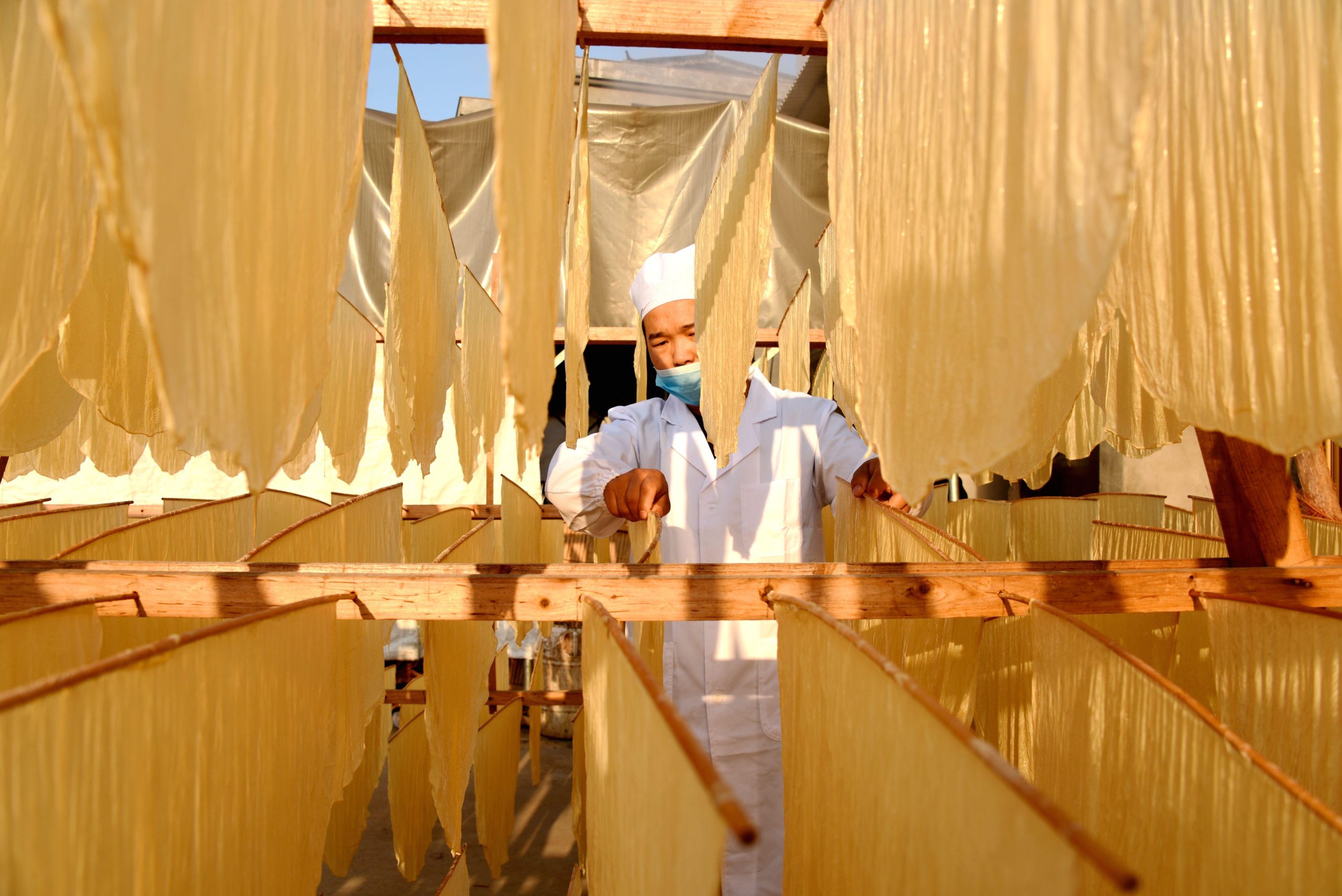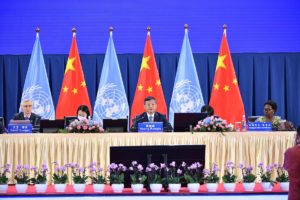Despite the economic prosperity the globalised soybean industry has brought, it remains a volatile one that is often associated with deforestation and biodiversity loss. However, looking back at the history of the miracle crop, it has been a direct source of protein for humans and often sourced locally.
While China has built up a global trademark for the famous Pu’er fermented tea and associated it with its place of origin in the southwestern province of Yunnan, the origin of soybeans is less commonly known, lacking the prestige and cultural reputation of the tea.
Part of the challenge for soybeans to build up a prestigious reputation, like tea, is that domestically produced soybeans and imported soybeans are not adequately recognised as distinct products that have starkly different uses in China.
Soybeans’ history in China: green human sustenance
Having first been domesticated in China’s northeast thousands of years ago, most of China’s total domestic soybean production remains located in Heilongjiang province, which prides itself on its black soil and non-genetically modified cultivation to produce safe, healthy and green soybeans.
Just like Chinese tea leaves, Chinese soybeans travelled around the world, now being produced in nearly all corners of the globe. Brazil, now the world’s largest exporter of soybeans, is believed to have got its first batch of soybean seeds directly from the then-troubled northeast China (then known as Manchuria) in the 1930s.
China also invented the methods for transforming soybeans into different varieties of tofu, and there were earlier efforts to introduce it outside of East Asia. In the 1900s, Li Shizeng, the educator and an early member of the Chinese Nationalist Party, registered patents for tofu-making – a process akin to that of cheese and yoghurt – in France. He opened a tofu factory in Paris, which supported Chinese students, some of whom would later become prominent revolutionaries, to serve as a prototype for an industry he believed could help China to meet its dietary needs.
In 1917, a Chinese doctor named Yamei Kin was sent by the US Department of Agriculture to her home country to research soybeans as a source of protein to feed American soldiers during World War I. As a celebrity dietitian of her time, Dr. Kin introduced soybeans as a healthy and “nutritious alternative to meat, that required fewer natural resources to produce”.
The story of soybeans diverged in China during the reform and opening-up period, starting from 1978, when the feed sector was endorsed by the government as a key industry to transition China’s consumption towards a more protein-rich diet including meat, poultry and milk, using soybeans as a protein for animal feed and increasing demand exponentially.
85%
is the share of China's total soybean consumption that animal feed accounts for
Today, as the largest importer and consumer of soybeans globally, nearly 85% of China’s soybean consumption is hidden in animal feed, mainly imported from Brazil, the US and Argentina. Nevertheless, China is still the fourth-largest producer globally, providing GMO-free soybeans for direct human consumption.
The world largely focuses on the implications of China’s soybean imports, overlooking domestic production in China. However, these two sides of the soybean story are interrelated. With high-quality and sustainable development the central theme of China’s 14th Five-Year Plan, China emphasises the interconnectedness of people’s well-being and environmental protection. With safety and quality assurance becoming the business norm in China and an entry-level requirement for consumers, sustainability and “greening” are becoming the next steps for government and businesses with regard to soft commodities such as soybeans. This has implications for both soy as a domestically grown food and imported feed.
Greening China’s domestic soybean production
Up until 2017, China’s northeast saw a steady decline in the total soybean planting area, as farmers lacked the incentive to grow soybeans when they could get a better price and subsidies to grow corn. At the same time, they faced lower yields in comparison to other producing countries such as Brazil and the US.
While the sustainability challenges in China’s soy production are rooted in the economic viability for farmers, Heilongjiang province already considers its production to be “green”, and free of deforestation risk. The region continues to provide soybeans to meet the demands for China’s vast varieties of tofu, soy milk and soy sauce products – everyday products consumed across the country, comparable to milk and cheese consumed across Europe.
Based on consumer preference and perceptions, China has maintained a strict GMO-free policy for products that are for direct human-consumption, with Heilongjiang province a GMO-free soybean planting region. The province also requires soybean companies that operate both domestic and imported soybean crushing to ensure segregation practices for GMO-free soybeans to ensure they are not mixed.
China will continue to rely on soybean imports, but will be demanding assurances that they are high-quality and sustainable
This has led the industry to adopt its own traceability systems. The system that was put in place to guarantee GMO-free soybeans has provided a foundation for the new trend of greening the industry. Jiusan Group, a large soybean growing, processing and trading enterprise, launched its green traceability system back in 2018. The initiative was updated this year with the utilisation of China’s organic and green certification standards, in an effort to provide consumers with health and quality assurance. Details on the initiative, however, are still vague and limited.
With government encouragement, industries in China are increasingly turning to international standards as an important benchmarking tool to guarantee quality, safety and green products, whilst at the same time enabling companies to sell products at a higher price. China’s leading soybean oil brands built up a reputation to provide green, healthy and safe soybeans, notably sourced from China’s northeast region.
Back in 2014, the state-owned Sinograin North Agriculture Company was a pioneer, to first implement an international soy standard in China, certifying its 24,000 hectares of soybeans under the internationally recognised Round Table for Responsible Soy (RTRS) certification criteria. With support from the China Soybean Industry Association and the Dutch-based organisation Solidaridad Network, this was the first social undertaking of its kind by a Chinese enterprise, despite the lack of any market demand for responsibly produced soybeans.
While RTRS certification guarantees environmental and social responsibility, including zero deforestation and conversion, the direct benefit to Sinograin was adhering to Good Agricultural Practices, to reduce fertiliser and chemical use, improve soy management and crop rotation, and improving the overall production management system, which provided more assurance to achieve higher yields. This drew the interest of neighbouring farmers, who joined Sinograin’s RTRS certification training. Sinograin also sells the RTRS-certified soy credits to European buyers and the physical beans are sold to leading Chinese tofu brands.
This cooperation between Sinograin North and RTRS is symbolic for soybean producers worldwide, as this joint effort helps to build up the reputation of Heilongjiang’s famed soybeans. Now, RTRS-certified soy in China is gaining traction and interest from other companies and stakeholders. Heilongjiang soybeans are being sought after not only by domestic companies, but also in Europe, Japan and South Korea, though in small volumes, with the rise in demand for plant-based proteins for direct human consumption.
Plant-based proteins give domestic soybeans a boost
While soybeans have been hidden and fed into rising animal protein consumption globally, they are now making a comeback as the sought-after plant-based protein for humans that they once were. This is also true for China, among its younger generations in particular, who choose to eat less meat for health reasons, and also care about animal protection and the environment.
Multinational meat companies, Chinese start-ups and investors alike are optimistic about the growing plant-based industry in China. In June 2020, Cargill launched its plant-based brand “PlantEver”, selling plant-based nuggets in KFC restaurants across China, and through its e-commerce site. On the packaging, PlantEver’s slogan highlights “protecting the environment and animal welfare”. Unsurprisingly, the plant-based brands in China rely on soybeans sourced from China’s northeast region as the main protein ingredient. The price of plant-based products is similar to meat products, if not more expensive, which increases the value of these soybean-based plant protein products.

While the trend is unlikely to drastically reduce overall meat consumption within China, the plant-based industry is growing with the change in consumer preferences. Besides the environmental benefits of the plant-based food industry, the preference of the brands and companies for regional sourcing creates new opportunities to market China’s domestic soybeans as a sought-after trademark.
Consumers in the EU and US are also increasingly demanding plant-based proteins from GMO-free, deforestation-free soybeans. It is nothing new to see European buyers coupling GMO-free with deforestation-free as requirements for the sourcing of soybeans, based on consumer preferences and concern about the environment and deforestation, which governments share. Europe is turning to both regional sourcing and other regions to fulfill these requirements, and often willing to pay a premium price.
Therefore, just as Pu’er tea has built up a high-value reputation that makes consumers willing to pay more for tea, Heilongjiang soybeans now have the opportunity to develop a similar reputation in plant-based proteins, including tofu. This requires transparent and traceable sustainability actions, and clear differentiation in the market that demonstrates their high quality and sustainability through brand recognition and eco-labelling.
Sustainability can be the new trend in China’s soy imports
Soybeans’ other identity is as an internationally traded commodity. China continues to rely on soybean imports to meet the ever-increasing demand for feed. With the animal husbandry sector – particularly swine, poultry and aquaculture industries driving the demand – these industries are also making efforts to green their supply chains.
China will continue to rely on soybean imports, but will be demanding assurances that they are high-quality and sustainable. Government and financial institutions are recognising deforestation and habitat loss as the greatest risks in the soy industry. COFCO International, the trading arm of COFCO Group, made commitments last year to achieve full traceability of its direct soy suppliers in Brazil by 2023. In 2017, the China Meat Association and WWF, together with over 60 member company signatories, launched the China Sustainable Meat Declaration, calling on concerted actions towards promoting sustainable meat production, trade and consumption.
More recently, the poultry company Sunner Group, announced its commitment to achieve zero deforestation in its soybean supply chain, working with the non-profit disclosure system CDP to develop a plan to achieve this target. The big question remains: is the rest of the world ready for China’s growing demand for sustainable soybeans?
In response to China’s growing emphasis on sustainability, the US Soy Association, representing the second largest soybean-producing country globally after Brazil, has been actively promoting its own sustainable soy production scheme, the Soy Sustainability Assurance Protocol (SSAP), in China. As a national sustainability scheme, SSAP ensures social and environmental responsibility, including biodiversity protection and zero deforestation, but also good labour conditions. The programme provides an SSAP-verified certificate free-of-charge for Chinese buyers.
In 2020, Liyang Chen Qiang Special Aquaculture Products Farm in Jiangsu province became the first yellow catfish farm to successfully receive certification. The company uses feed only produced with SSAP-verified soybean products. This sets a good example of soybean producers implementing sustainability and marketing in China across the supply chain. At the same time, Chinese soybean buyers are able to differentiate US soybeans with the guarantee that the soybeans are deforestation-free.
The world may continue to look at soybeans as just a “commodity”. However, the history and origin of soybean production, and the reclaiming of the reputation of soybeans as a healthy protein, has enabled Heilongjiang to differentiate its soybeans and become increasingly sought-after. While the soy industry continues to rapidly evolve and shape its dual identity, both sides of the story demonstrate a greater emphasis on human well-being coupled with environmental protection, to contribute to China’s goals for achieving carbon neutrality and ecological civilisation.
The trends in China undoubtedly have a global impact, creating new and more value-added opportunities for soy producers across the globe. In the complex and fragmented global soy supply chain, producing countries will be at an advantage when they can differentiate soybeans by origin and guarantee that the soybeans are safe and green. Providing effective market mechanisms, such as the use of international standards and eco-labelling, will bring added value and draw the linkage between producers and key markets such as China.









